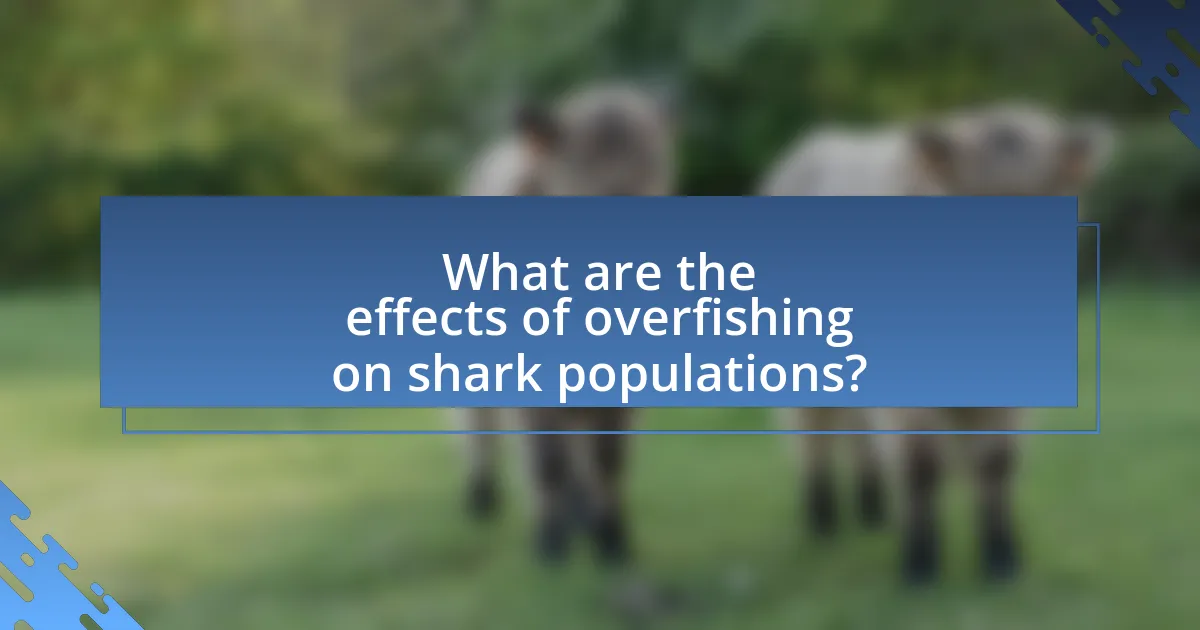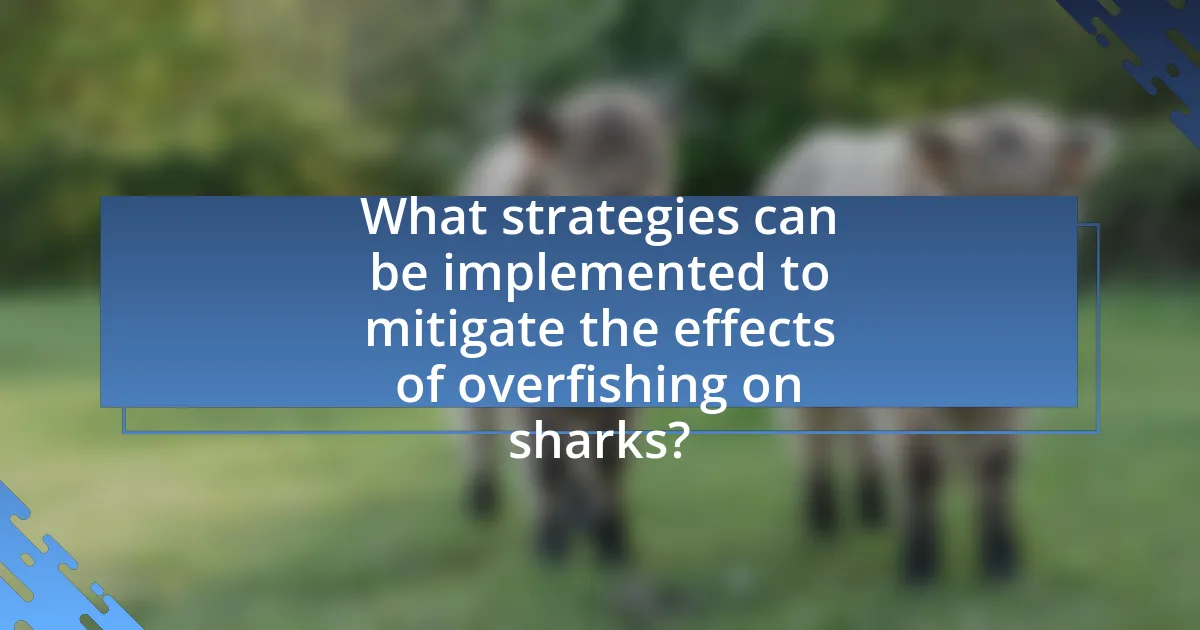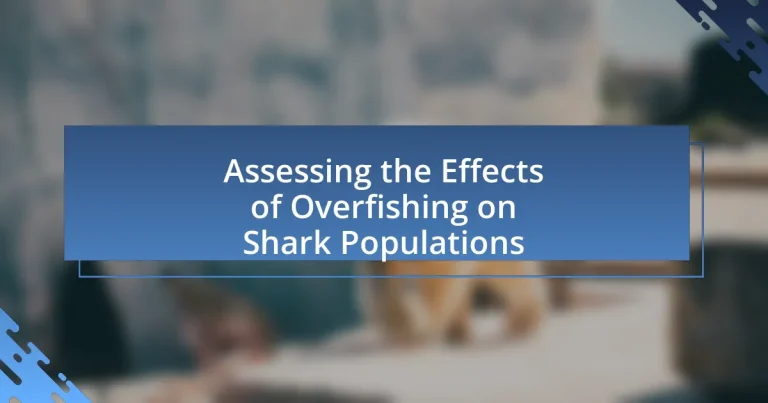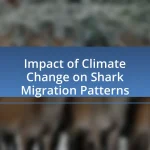The article focuses on assessing the effects of overfishing on shark populations, highlighting the significant decline in global shark numbers, which have decreased by over 70% in recent decades due to targeted fishing and bycatch. It discusses the ecological consequences of this decline, including reduced species diversity, disrupted marine ecosystems, and the critical role sharks play as apex predators in maintaining marine balance. The article also examines specific shark species most affected by overfishing, the methods used to assess shark populations, and the challenges faced in conservation efforts. Additionally, it outlines strategies for mitigating overfishing impacts, including sustainable fishing practices, improved regulations, and the establishment of marine protected areas.

What are the effects of overfishing on shark populations?
Overfishing significantly reduces shark populations, leading to decreased biodiversity and disrupted marine ecosystems. As apex predators, sharks play a crucial role in maintaining the balance of marine life; their decline can result in overpopulation of prey species, which in turn affects the entire food web. Research indicates that global shark populations have declined by over 70% in the last few decades due to overfishing practices, including targeted fishing and bycatch. This decline not only threatens the survival of various shark species but also impacts the health of ocean ecosystems, as evidenced by studies from the International Union for Conservation of Nature (IUCN) and the Food and Agriculture Organization (FAO).
How does overfishing impact shark species diversity?
Overfishing significantly reduces shark species diversity by depleting populations and disrupting ecological balance. As shark numbers decline due to excessive fishing, the genetic diversity within species diminishes, leading to increased vulnerability to diseases and environmental changes. Research indicates that overfishing has led to a 70% decline in some shark populations globally, which directly correlates with a loss of species diversity in marine ecosystems. This decline affects not only the sharks themselves but also the overall health of oceanic environments, as sharks play a crucial role in maintaining the balance of marine life.
What specific shark species are most affected by overfishing?
The specific shark species most affected by overfishing include the Great Hammerhead, the Scalloped Hammerhead, and the Oceanic Whitetip Shark. These species are particularly vulnerable due to their slow growth rates, late maturity, and low reproductive output, which make them less resilient to population declines. For instance, the Great Hammerhead has experienced a population decline of over 80% in some regions, primarily due to targeted fishing for their fins and meat. The Scalloped Hammerhead is listed as endangered by the International Union for Conservation of Nature (IUCN), reflecting its critical status as a result of overfishing pressures. The Oceanic Whitetip Shark has also seen significant reductions in its numbers, with estimates indicating a decline of up to 90% in certain areas, largely due to bycatch in longline fisheries.
How does the loss of diversity affect marine ecosystems?
The loss of diversity negatively impacts marine ecosystems by disrupting food webs and reducing resilience to environmental changes. When species diversity declines, the stability of ecosystems is compromised, leading to increased vulnerability to diseases and climate change. For instance, a study published in the journal “Nature” found that ecosystems with higher biodiversity are better able to withstand disturbances, such as overfishing, which directly affects predator-prey relationships and can lead to population collapses. Additionally, the decline of key species, such as sharks, due to overfishing can result in trophic cascades, where the removal of top predators leads to an overabundance of prey species, further destabilizing the ecosystem.
What are the ecological consequences of declining shark populations?
Declining shark populations lead to significant ecological consequences, primarily disrupting marine ecosystems. Sharks are apex predators, and their reduction can cause a phenomenon known as trophic cascades, where the decline in shark numbers allows prey species, such as smaller fish and rays, to proliferate unchecked. This overpopulation can result in the depletion of essential species, such as herbivorous fish, which play a critical role in maintaining coral reef health by controlling algae growth. Research indicates that areas with fewer sharks experience a decline in biodiversity and overall ecosystem stability, as evidenced by studies showing that regions with healthy shark populations have more balanced marine communities.
How do sharks contribute to the health of marine environments?
Sharks contribute to the health of marine environments by maintaining the balance of marine ecosystems through their role as apex predators. By controlling the populations of prey species, such as smaller fish and marine mammals, sharks help prevent overgrazing of vital habitats like seagrass beds and coral reefs. This predatory behavior promotes biodiversity, as it allows various species to thrive and maintain ecological balance. Studies have shown that in areas where shark populations have declined, there is often a corresponding increase in the populations of herbivorous fish, leading to the degradation of coral reefs due to overconsumption of algae. Therefore, the presence of sharks is crucial for the overall health and stability of marine ecosystems.
What role do sharks play in regulating fish populations?
Sharks play a crucial role in regulating fish populations by acting as apex predators that maintain the balance of marine ecosystems. Their predation helps control the abundance and diversity of prey species, preventing any single fish population from becoming overly dominant. For instance, studies have shown that the decline of shark populations due to overfishing can lead to an increase in smaller fish species, which can disrupt the entire marine food web. Research published in the journal “Ecology Letters” by Ferretti et al. (2010) indicates that the removal of sharks can result in significant changes in community structure and biodiversity, highlighting their importance in maintaining ecological balance.
Why is it important to assess the effects of overfishing on sharks?
Assessing the effects of overfishing on sharks is crucial for maintaining marine biodiversity and ecosystem health. Sharks play a vital role as apex predators, helping to regulate the populations of other marine species and maintain the balance of the ocean ecosystem. Overfishing can lead to significant declines in shark populations, which disrupts these ecological functions. For instance, studies have shown that the removal of sharks can result in an increase in smaller fish populations, leading to overgrazing of seagrass and coral reefs, ultimately harming the entire marine environment. Therefore, understanding the impacts of overfishing on sharks is essential for effective conservation strategies and sustainable fisheries management.
What are the long-term implications for marine biodiversity?
The long-term implications for marine biodiversity due to overfishing, particularly of sharks, include significant declines in species diversity and ecosystem stability. Overfishing disrupts food webs, as sharks play a crucial role as apex predators, maintaining the balance of marine ecosystems. Research indicates that the removal of sharks can lead to an increase in smaller predatory fish, which in turn can deplete herbivorous fish populations, resulting in overgrowth of algae and detrimental effects on coral reefs. A study published in the journal “Nature” by Ferretti et al. (2010) highlights that the decline of shark populations can lead to cascading effects throughout marine ecosystems, ultimately reducing biodiversity and altering habitat structures.
How does overfishing of sharks affect human communities?
Overfishing of sharks negatively impacts human communities by disrupting marine ecosystems and diminishing fish populations that are vital for local fisheries. Sharks play a crucial role as apex predators, maintaining the balance of marine life; their decline leads to overpopulation of certain species, which can result in the collapse of fish stocks that communities rely on for food and income. For instance, studies indicate that regions with reduced shark populations experience significant declines in commercially important fish species, affecting livelihoods and food security for coastal communities.

What methods are used to assess the effects of overfishing on shark populations?
Methods used to assess the effects of overfishing on shark populations include population modeling, catch data analysis, and ecological surveys. Population modeling utilizes mathematical frameworks to predict changes in shark numbers based on fishing rates and reproductive rates. Catch data analysis examines historical and current fishing records to evaluate trends in shark landings, which can indicate population health. Ecological surveys involve field studies that assess shark abundance and distribution in various habitats, providing insights into the impacts of overfishing on their ecosystems. These methods collectively help researchers understand the extent of overfishing’s impact on shark populations and inform conservation strategies.
How do researchers collect data on shark populations?
Researchers collect data on shark populations primarily through methods such as tagging, surveys, and genetic analysis. Tagging involves attaching electronic devices to sharks to track their movements and behavior, providing insights into population dynamics and migration patterns. Surveys, including visual counts and catch data, help estimate population sizes and distribution. Genetic analysis allows researchers to assess genetic diversity and population structure, which are critical for understanding the health and resilience of shark populations. These methods are validated by studies demonstrating their effectiveness in monitoring shark populations and informing conservation strategies.
What technologies are used in shark population assessments?
Technologies used in shark population assessments include satellite tagging, acoustic telemetry, and genetic analysis. Satellite tagging allows researchers to track the movements and behaviors of sharks over large distances, providing data on migration patterns and habitat use. Acoustic telemetry involves placing transmitters on sharks to monitor their presence in specific areas, which helps in understanding population density and distribution. Genetic analysis is utilized to assess genetic diversity and population structure, offering insights into the health and viability of shark populations. These technologies collectively enhance the accuracy of population assessments and inform conservation strategies.
How do scientists measure the impact of fishing on shark numbers?
Scientists measure the impact of fishing on shark numbers primarily through population assessments and data collection methods such as catch data analysis, tagging studies, and ecological modeling. Catch data analysis involves examining the number of sharks caught over time, which helps estimate population trends and fishing pressure. Tagging studies track individual sharks to gather information on their movement patterns, survival rates, and reproductive success, providing insights into population dynamics. Ecological modeling incorporates various data sources to simulate shark populations under different fishing scenarios, allowing scientists to predict future trends and assess the sustainability of fishing practices. These methods collectively provide a comprehensive understanding of how fishing affects shark populations, supported by studies such as those published in the journal “Fish and Fisheries,” which highlight the importance of these approaches in conservation efforts.
What indicators are used to evaluate shark population health?
Indicators used to evaluate shark population health include population size, age structure, reproductive rates, and genetic diversity. Population size provides a direct measure of abundance, while age structure indicates the balance of juvenile and adult sharks, which is crucial for sustainability. Reproductive rates reflect the ability of the population to replenish itself, and genetic diversity is essential for resilience against diseases and environmental changes. Studies have shown that declines in these indicators often correlate with overfishing, highlighting their importance in assessing the overall health of shark populations.
How is reproductive success measured in shark populations?
Reproductive success in shark populations is measured primarily through metrics such as the number of offspring produced, survival rates of those offspring, and the frequency of successful mating events. Researchers often assess these metrics by conducting field studies that involve tracking breeding behaviors, monitoring gestation periods, and evaluating the health and viability of pups at birth. For instance, studies have shown that species like the blacktip reef shark can produce up to 10 pups per litter, and survival rates can vary significantly based on environmental conditions and parental care. These measurements provide critical insights into population dynamics and the overall health of shark populations, particularly in the context of overfishing, which can severely impact reproductive rates and success.
What role do size and age distribution play in assessments?
Size and age distribution are critical in assessments of shark populations as they provide insights into the health and sustainability of the species. Specifically, size distribution indicates the range of individuals within a population, which can reflect reproductive potential and vulnerability to fishing pressures. Age distribution reveals the demographic structure, highlighting the presence of younger, mature, and older sharks, which is essential for understanding population dynamics and resilience. For instance, a study published in the journal “Marine Ecology Progress Series” by Dulvy et al. (2014) emphasizes that skewed age distributions due to overfishing can lead to population declines, as fewer mature individuals remain to reproduce. Thus, analyzing size and age distribution is vital for effective management and conservation strategies for shark populations.
What challenges do researchers face in assessing shark populations?
Researchers face significant challenges in assessing shark populations due to the elusive nature of sharks, which makes direct observation difficult. The vastness of marine environments complicates data collection, as sharks inhabit large and often inaccessible areas. Additionally, traditional survey methods, such as visual counts or tagging, can be limited by factors like water clarity and the behavior of sharks, leading to incomplete data. Furthermore, the lack of standardized methodologies across different regions can result in inconsistent data, making it hard to compare populations globally. According to a study published in the journal “Marine Ecology Progress Series,” researchers have noted that these challenges hinder effective management and conservation efforts for shark species, which are increasingly threatened by overfishing.
How does illegal fishing complicate population assessments?
Illegal fishing complicates population assessments by introducing unregulated catch data that skews the understanding of species abundance. This unreported fishing activity leads to inaccurate estimates of shark populations, as it is difficult to account for the number of individuals removed from the ecosystem. Studies indicate that illegal fishing can account for up to 30% of total catch in some regions, significantly impacting the reliability of population models and conservation efforts. Consequently, the lack of accurate data hampers effective management strategies aimed at preserving shark populations.
What limitations exist in current research methodologies?
Current research methodologies in assessing the effects of overfishing on shark populations face several limitations, including a lack of standardized data collection, insufficient long-term studies, and challenges in accurately modeling complex ecological interactions. The absence of standardized protocols leads to inconsistencies in data, making it difficult to compare results across different studies. Additionally, many studies are short-term, which limits the understanding of long-term population dynamics and recovery patterns. Furthermore, ecological modeling often struggles to incorporate the multifaceted interactions between sharks and their environment, leading to oversimplified conclusions. These limitations hinder the ability to make informed conservation decisions and effectively manage shark populations.

What strategies can be implemented to mitigate the effects of overfishing on sharks?
To mitigate the effects of overfishing on sharks, implementing sustainable fishing practices is essential. These practices include establishing catch limits based on scientific assessments, enforcing seasonal fishing closures to protect breeding populations, and promoting the use of selective fishing gear that reduces bycatch. For instance, the International Union for Conservation of Nature (IUCN) emphasizes that effective management strategies can lead to the recovery of shark populations, as seen in regions where catch limits have been enforced, resulting in a 20% increase in certain shark species over a decade. Additionally, creating marine protected areas (MPAs) can provide safe habitats for sharks, allowing populations to thrive without the pressures of fishing. Research indicates that MPAs can enhance biodiversity and increase fish stocks, benefiting both ecosystems and fisheries.
How can fishing regulations be improved to protect shark populations?
Fishing regulations can be improved to protect shark populations by implementing stricter catch limits, establishing marine protected areas, and enforcing bans on shark finning. Stricter catch limits can prevent overfishing by ensuring that shark populations are not depleted beyond sustainable levels; for instance, the International Union for Conservation of Nature (IUCN) recommends specific quotas based on scientific assessments of shark stocks. Marine protected areas can provide safe habitats where sharks can thrive without the pressures of fishing, as evidenced by studies showing increased shark populations in such zones. Additionally, enforcing bans on shark finning can significantly reduce the mortality rates of sharks, as this practice often leads to the unnecessary killing of sharks for their fins, which are highly valued in some markets. These measures, supported by data from organizations like the World Wildlife Fund, can collectively enhance the resilience of shark populations against the threats posed by overfishing.
What types of fishing quotas are effective for shark conservation?
Effective fishing quotas for shark conservation include total allowable catch (TAC) limits, species-specific quotas, and bycatch reduction measures. TAC limits set a maximum number of sharks that can be caught, which helps prevent overfishing and allows populations to recover. Species-specific quotas target particular shark species that are more vulnerable to overfishing, ensuring that their populations are adequately protected. Bycatch reduction measures, such as gear restrictions and seasonal closures, minimize the accidental capture of sharks, further supporting their conservation. Research indicates that regions implementing these quota systems have seen improvements in shark population stability, demonstrating their effectiveness in conservation efforts.
How can bycatch reduction techniques be implemented?
Bycatch reduction techniques can be implemented through the use of specialized fishing gear, modifications in fishing practices, and the establishment of marine protected areas. Specialized gear, such as circle hooks and escape devices, minimizes the capture of non-target species, while modifications like adjusting net mesh sizes can further reduce bycatch rates. Additionally, marine protected areas can limit fishing activities in critical habitats, allowing vulnerable species, including sharks, to recover. Research indicates that implementing these techniques can lead to a significant decrease in bycatch, with studies showing reductions of up to 50% in certain fisheries.
What role do marine protected areas play in shark conservation?
Marine protected areas (MPAs) play a crucial role in shark conservation by providing safe habitats where sharks can thrive without the pressures of overfishing and habitat degradation. MPAs help to increase shark populations by limiting fishing activities, which allows for the recovery of depleted species. For instance, studies have shown that in areas where fishing is restricted, shark populations can increase by up to 50% over a few years, demonstrating the effectiveness of MPAs in promoting biodiversity and ecosystem health. Additionally, MPAs contribute to the protection of critical habitats such as breeding and nursery grounds, which are essential for the life cycle of many shark species.
How do marine reserves benefit shark populations?
Marine reserves benefit shark populations by providing protected habitats that reduce fishing pressure and allow for population recovery. These reserves create safe environments where sharks can thrive, reproduce, and grow without the threat of overfishing. Research indicates that marine reserves can lead to increased shark abundance and biodiversity, as seen in studies conducted in the Bahamas, where shark populations increased by over 300% within protected areas compared to fished regions. This evidence demonstrates that marine reserves are effective in enhancing the resilience and sustainability of shark populations.
What are the challenges in establishing marine protected areas?
Establishing marine protected areas (MPAs) faces several challenges, including stakeholder opposition, inadequate funding, and regulatory complexities. Stakeholder opposition often arises from local communities and industries that rely on marine resources for their livelihoods, leading to resistance against restrictions. Inadequate funding hampers the implementation and management of MPAs, as financial resources are essential for enforcement and monitoring activities. Regulatory complexities involve navigating various legal frameworks and jurisdictions, which can delay the establishment process. These challenges hinder the effective creation and management of MPAs, ultimately impacting conservation efforts for marine biodiversity, including shark populations.
What actions can individuals take to support shark conservation?
Individuals can support shark conservation by reducing their consumption of shark products, advocating for sustainable fishing practices, and participating in local conservation efforts. By choosing not to buy shark fin soup or other shark-derived products, individuals can directly decrease demand, which is a significant factor in overfishing. Advocacy for sustainable fishing practices can involve supporting legislation that protects shark habitats and promotes responsible fishing methods. Additionally, participating in local conservation initiatives, such as beach clean-ups or educational programs, helps raise awareness and fosters community involvement in shark protection. These actions collectively contribute to the preservation of shark populations, which are vital for marine ecosystems.
How can consumer choices impact shark populations?
Consumer choices significantly impact shark populations by influencing demand for shark products, leading to overfishing. When consumers purchase shark meat, fins, or other products, they contribute to the market that drives fishing practices, often resulting in unsustainable catch levels. For instance, the global demand for shark fins has led to the practice of finning, where sharks are caught, their fins removed, and the bodies discarded, which has contributed to a decline in shark populations by up to 90% in some regions. Additionally, consumer preferences for sustainable seafood can help mitigate this impact; choosing alternatives reduces pressure on shark populations and promotes responsible fishing practices.
What are effective advocacy strategies for shark conservation?
Effective advocacy strategies for shark conservation include public awareness campaigns, policy advocacy, and community engagement. Public awareness campaigns educate the general population about the ecological importance of sharks and the threats they face, which can lead to increased support for conservation efforts. Policy advocacy involves lobbying for stronger regulations and protections for shark species, such as bans on shark finning and the establishment of marine protected areas. Community engagement fosters local stewardship by involving fishermen and coastal communities in sustainable practices, ensuring that they benefit from conservation efforts. Research indicates that regions with active community involvement in conservation see better outcomes for shark populations, highlighting the effectiveness of these strategies.


